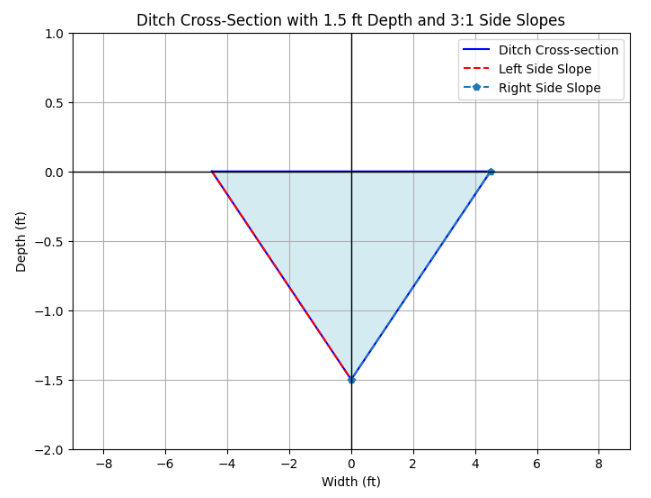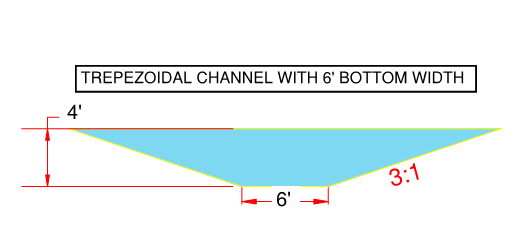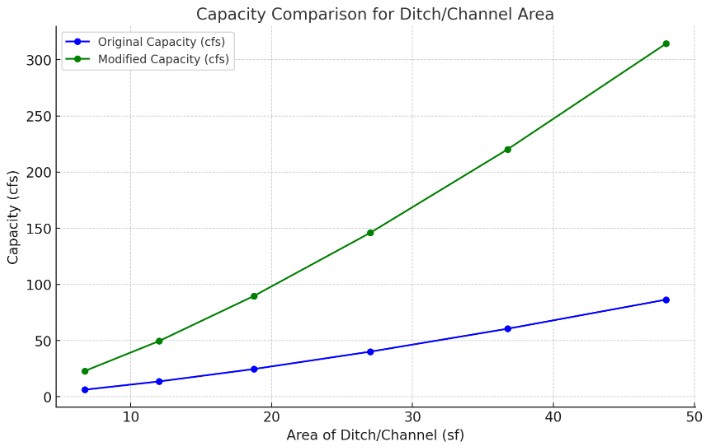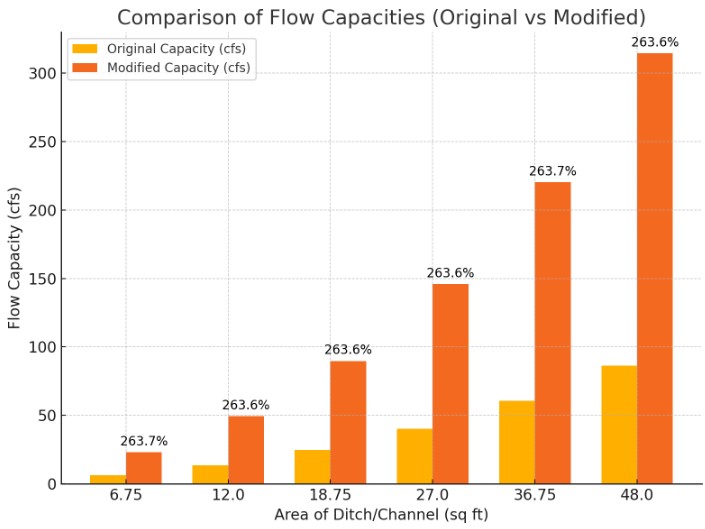Ijraset Journal For Research in Applied Science and Engineering Technology
- Home / Ijraset
- On This Page
- Abstract
- Introduction
- Conclusion
- References
- Copyright
Sustainable Flood Mitigation: Improving Stormwater Infrastructure with PVC for Enhanced Hydraulic Performance
Authors: Prathamesh Bhoir, Akshay Dumbre
DOI Link: https://doi.org/10.22214/ijraset.2024.64481
Certificate: View Certificate
Abstract
The escalating impacts of climate change, coupled with rapid urbanization, have placed unprecedented strain on existing stormwater infrastructure. Frequent and intense rainfall events often overwhelm aging stormwater channels and ditches, leading to flooding and property damage. Traditional upgrades, such as concrete lining, are often costly and disruptive. This research explores the potential of PVC sheets as a viable and cost-effective solution to enhance the hydraulic capacity of these channels. By lining the slopes and bases of stormwater channels with PVC, we can significantly reduce the roughness coefficient, thereby improving flow efficiency and increasing the channel’s capacity to handle larger volumes of stormwater. PVC lining is relatively inexpensive, durable and resistant to corrosion, ensuring long-term performance and reducing maintenance costs. Computational analysis has demonstrated the effectiveness of PVC lining, showing that it can increase channel capacity while minimizing costs and disruptions. This innovative approach presents a promising solution for municipalities seeking to adapt to changing climate conditions and ensure the resilience of their stormwater systems.
Introduction
I. INTRODUCTION
Many big cities are struggling with a mounting stormwater infrastructure crisis as urbanization accelerates and climate change intensifies rainfall events. Many stormwater channels and ditches, designed decades ago with outdated hydrological data, are now woefully inadequate to handle modern runoff volumes. The American Society of Civil Engineers (ASCE) 2021 report’s ”D” grade for U.S. stormwater infrastructure underscores the critical capacity issues. This inability to adapt to the changing climate poses significant flood risks and threatens public safety, particularly in rapidly growing urban areas. The limited land available in these areas makes expand- ing stormwater channels nearly impossible without disrupting urban development, presenting a major challenge for local governments. Though it is technically difficult to re-plan the city structures in the current scenario, it is possible to adapt to and mitigate the effects of natural hazards through suitable planning and management with the integrated cooperation and involvement of citizens and government as well [16]. Through- out the world, but particularly at low latitudes, cities of all sizes are growing but also facing increasing environmental hazards, particularly those associated with climate change [18]. As the world’s population is expected to be over 2/3rd urban by 2050, climate action in cities is a growing area of interest in the inter-disciplines of development policy, disaster mitigation and environmental governance [19].
Stormwater management is the science of managing stormwater runoff to prevent adverse impacts on the environment [2].The lack of strategic planning in stormwater management has made rapidly urbanizing cities more vulnerable to urban water issues than in the past [1]. Proper management of stormwater drainage may be a solution to urban flooding problems but suitable selection of model for a particular watershed is a challenge [8]. The adverse impacts of the tra- ditional practice of urban stormwater management have raised growing concerns about the natural environment [4]. Major causes of urban flooding are well known and include a com- bination of urbanization, heavy rainfall over the cities and/or upstream catchments, overflows from upstream dams/rivers, construction on the flood plains or low-lying areas in the cities [9]. Research on the viability of urban stormwater drainage systems and the search for solutions to the related problems constitute an important prerequisite for their sustainability evaluation [3]. Due to rapid urbanization, the natural landcover in the cities is being replaced with impervious surfaces which significantly alters the natural patterns and processes of urban landscape resulting in mismanagement of storm water and hence the flooding issues [5]. Across the globe, the damage caused by urban floods has increased manifold[7]. The severity of flood was extreme and the financial cost of the flood was unprecedented [13]. In terms of economic losses, floods have been more devastating than any other disaster [14]. Flood is most prevalent and costliest natural disaster in the world which devastates both life and economy at a large extent [15].
Flood, a distinctive natural calamity, has occurred more frequently in the last few decades all over the world, which is often an unexpected and inevitable natural hazard, but the losses and damages can be managed and controlled by adopting effective measures [17]. Ultimately, the implementation of effective stormwater management strategies is imperative to ensure the long-term viability and resilience of urban infrastructure in the face of escalating flood risks [6].
Sustainability is a pressing concern for cities worldwide, especially as they face the challenges of climate change. Increasingly frequent and intense flooding events pose sig- nificant risks. To mitigate the flood risks, cities must up- grade their stormwater infrastructure. By prioritizing resilient stormwater management, cities can create more sustainable and livable environments that can withstand the impacts of climate change. Therefore, the ‘environmental friendly’ approach should be applied when dealing with storm water runoff [20]. There is a clear trend in the world to increase the use of sustainable drainage systems [24]. Stormwater system design often relies on Manning’s equation, which calculates channel capacity based on area, slope, hydraulic radius, and roughness coefficient. While area, slope, and hydraulic radius are generally fixed in urban environments, the roughness co- efficient is modifiable. A smoother surface reduces roughness, allowing water to flow more efficiently, increasing channel capacity. Older channels with rough or vegetated surfaces often have high roughness coefficients (e.g., 0.04), limiting their efficiency. Channel roughness is the most sensitive parameter in development of hydraulic model for flood forecasting and flood plain mapping [10]. A channel includes irrigation chan- nels, roadside channels and drainage ditches that are either man-made with regular geometric cross sections or unlined or lined with artificial or natural material to protect against erosion [11]. The coefficient of Manning’s roughness (n) has been generally implemented in the determination of depth and discharge in open channels and canals [12]. Improving the roughness coefficient is crucial for enhancing existing stormwater system’s performance. Applying PVC sheets to channel slopes and bases can drastically reduce the roughness coefficient to 0.011, significantly boosting hydraulic capacity. This approach offers a practical and cost-effective way to retrofit aging infrastructure without extensive reconstruction or expansion, making it attractive for municipalities with space constraints and limited budgets. Smooth surface treatments can be implemented quickly, minimizing disruptions to urban activities while providing immediate flood mitigation benefits. This research aimed to evaluate the effectiveness of PVC sheets in increasing stormwater channel’s hydraulic capacity. A comparative analysis across various channel sizes examined the improvement in flow rates after applying PVC linings. Results showed that hydraulic capacities could increase by up to three times compared to channels with vegetated or rough surfaces. This substantial improvement highlights the tech- nique’s potential as a low-cost, high-impact solution for urban stormwater management. PVC sheets cost approximately 5 Dollars per square foot, making them financially viable com- pared to more expensive and labor-intensive concrete. This re- search also positions PVC lining within the broader context of sustainable urban development and climate resilience. Urban growth increases impervious surfaces like roads and buildings, which enhance runoff and reduce natural infiltration. This exacerbates pressure on stormwater systems, leading to more frequent and severe flooding. Retrofitting infrastructure with materials like PVC, which improve flow efficiency, can help cities manage stormwater more effectively while minimizing the need for land-intensive projects like stormwater detention ponds. The ability to retrofit existing infrastructure aligns with sustainable development goals and provides a pathway for cities to adapt to evolving environmental conditions without compromising urban growth. Addressing the capacity limita- tions of aging stormwater infrastructure is crucial for build- ing climate resilience in urban areas. PVC sheet application presents a cost-effective, scalable, and minimally disruptive method for enhancing hydraulic performance. This research provides empirical evidence of its efficacy and positions it as a practical solution for municipalities seeking to upgrade their stormwater systems to cope with future challenges posed by climate change and urbanization. The findings contribute to stormwater management innovation and offer a framework for cities to enhance their infrastructure sustainably and efficiently.
II. LITERATURE REVIEW
Existing research has extensively documented the challenges posed by outdated stormwater infrastructure, particularly as urbanization and climate change exacerbate flood risks. In modern cities, rainwater management is sometimes problematic due to years of neglect and the application of traditional technical methods in urban drainage [22]. There is a need to provide sustainable and resilient urban drainage systems to manage stormwater more efficiently [23]. Many stormwater channels and ditches in the United States were designed based on outdated rainfall data, leading to inadequate capacity for current and future precipitation patterns. Studies consistently advocate for infrastructure upgrades, ranging from channel expansion to stormwater detention ponds. Although several studies have explored the use of Manning’s equation to optimize stormwater systems, there has been limited research focused on modifying the roughness coefficient as a primary means of improving flow capacity.
While some studies have mentioned the use of smoother surfaces like concrete, the high cost and labor involved would make this impractical for many municipalities. A significant gap exists in the literature regard- ing low-cost retrofitting solutions for existing infrastructure in space-constrained urban environments. This research addresses this gap by investigating the application of PVC sheets to reduce the roughness coefficient of existing storm channels. By focusing on improving surface smoothness, this study provides a cost-effective alternative to traditional methods like concrete lining. This research contributes a novel approach within the current body of knowledge, balancing hydraulic efficiency with financial and spatial constraints, offering a practical solution for municipalities facing increasingly severe rainfall events.
III. METHODOLOGY
This research aims to investigate how PVC sheets can enhance stormwater channels and ditches’s hydraulic capac- ity by reducing the Manning’s roughness coefficient. The methodology focuses on comparing the hydraulic capacities of channels under different roughness conditions to demonstrate PVC’s effectiveness.
Manning’s equation is a widely used formula for calculat- ing open channel hydraulic capacity (flow rate). Manning’s formula highlights the relationship between channel roughness and hydraulic capacity. Reducing the roughness coefficient (n) increases the flow rate (Q) for a given cross-sectional area and slope.

Multiple existing stormwater channels and ditches of vary- ing sizes were selected for hydraulic analysis. These channels represent a range of typical urban stormwater systems, with diverse cross-sectional areas and slopes. By selecting channels with different geometric profiles, the study comprehensively assesses PVC sheet application’s impact across various con- ditions. The channels and ditches were modeled using trape- zoidal cross-sections and triangular cross sections, commonly found in stormwater management systems. Geometric proper- ties, including bottom width, side slopes, and channel depth, were recorded for each selected channel. Channel slopes (S) were were considered to be 0.1 percent across all the testing sections. This study focuses on altering n from 0.04 (vegetated or rough surfaces) to 0.011 (PVC-lined surfaces), representing a smoother surface that enhances storm water flow.
IV. RESULTS
The results of this study unequivocally demonstrate the significant impact of PVC sheet application on stormwater channel’s hydraulic capacity. Using Manning’s equation for hydraulic analysis, the flow rates of six different stormwater ditches and channels, each with varying cross-sectional areas, were calculated under two conditions: with a Manning’s roughness coefficient of 0.04 (representing rough, vegetated surfaces) and with a Manning’s roughness coefficient of 0.011 (representing a smooth PVC-lined surface).
We tested six channel sections. Two of these sections were a 1.5-foot ditch and a 4-foot deep trapezoidal channel with a 6-foot bottom width. Both sections were assumed to have a slope of 0.1 percent and were analyzed using two different roughness coefficients.
Fig.1 illustrates a ditch with a depth of 1.5 feet and a side slope ratio of 3:1. The ditch has a cross-sectional area of 6.75 square feet, a wetted perimeter of 9.49 feet, a slope of0.1 percent, and a roughness coefficient of 0.04. Using the Manning equation, the initial flow rate was calculated to be 6.319 cubic feet per second. By installing PVC sheets, the roughness coefficient was reduced to 0.011. This resulted in a significant increase in flow capacity to 22.98 cubic feet per second. This represents a 263 percent improvement over the original flow rate.

Fig. 1: Ditch with 1.5 feet depth

Fig. 2: Trapezoidal Channel with 4 feet depth
Fig.2 shows a trapezoidal storm channel with a depth of 4 feet, a bottom width of 6 feet, and side slopes of 3:1. The channel has a cross-sectional area of 72 square feet and a wetted perimeter of 31.30 feet. Assuming a slope of 0.1 percent and a roughness coefficient of 0.04, the initial flow rate was calculated to be 144.44 cubic feet per second. By installing PVC sheets, the roughness coefficient was reduced to 0.011. This resulted in a significant increase in flow capacity to 536.15 cubic feet per second. This represents a 263 percent improvement over the original flow rate.
The findings reveal a substantial increase in hydraulic capacity when the roughness coefficient is reduced. Similar improvements were observed across all other ditches and channels tested, with consistent increases in capacity.
Fig.3 presents a line graph comparing the original and modified hydraulic capacities of stormwater channels with cross-sectional areas ranging from 6.75 to 48 square feet. The

Fig. 3: Line Graph for Hydraulic Capacity Comaprison

Fig. 4: Bar Plot for Hydraulic Capacity Comaprison
blue line represents the original capacity before PVC sheet installation, using a roughness coefficient of 0.04. The green line illustrates the significantly increased capacity after PVC application, resulting from a reduced roughness coefficient to 0.011. The graph consistently demonstrates a substantial in- crease in capacity for all ditch and channel sizes, emphasizing the importance of surface smoothness in enhancing stormwater infrastructure efficiency. Fig.4 presents a bar plot comparing the original and modi- fied hydraulic capacities of stormwater channels with varying cross-sectional areas. The orange bars represent the modified channels, which demonstrate a consistent 263 percent increase in flow capacity due to the application of PVC sheets. This reduction in roughness coefficient from 0.04 to 0.011 high- lights the significant impact of smooth-surfacing techniques on stormwater infrastructure performance.
V. DISCUSSION
The results of this study unequivocally demonstrate that applying PVC sheets to existing stormwater channels is an exceptionally effective means of significantly enhancing hy- draulic capacity, especially in urban environments where space constraints limit infrastructure expansion. By reducing the Manning’s roughness coefficient from 0.04 to 0.011, we ob- served hydraulic capacity increases of over 260 percent in all tested channels. This improvement underscores the potential of smooth-surfacing methods, like PVC sheet installation, to significantly enhance the flow efficiency of stormwater systems, addressing challenges posed by increasing rainfall intensities and urbanization.
One of the key advantages of this approach is its cost- effectiveness compared to alternative methods like channel expansion or concrete lining. PVC sheets, priced at approx- imately 5 dollar per square foot, offer a substantially lower cost for improving hydraulic capacity than concrete pouring or acquiring additional land for channel expansion or detention ponds. While concrete lining effectively improves roughness, it is both labor-intensive and expensive, involving extensive excavation, formwork, and curing time. Conversely, PVC installation is relatively quicker and less disruptive, providing an economical retrofit solution for municipalities with limited budgets. Applying PVC sheets represents a sustainable and practical approach for upgrading aging stormwater systems without needing significant land resources or large capital investments.
Despite these clear benefits, PVC sheet installation presents some challenges. Anchoring the PVC sheets to the channel slopes and base, especially in channels with high flow velocities or uneven surfaces, is crucial to prevent displacement or detachment during heavy storm events. Techniques such as mechanical fasteners, adhesive bonding, or trenching the edges of the PVC sheets into the channel’s embankments can be employed to secure the material in place. Durability and longevity are also essential considerations. While PVC is highly resistant to chemical degradation and UV exposure, reg- ular maintenance will be required to inspect for any physical damage that could compromise its performance.
In terms of maintenance, PVC sheets offer the advantage of being relatively low-maintenance compared to concrete or vegetated surfaces, which can become overgrown or eroded over time. Routine inspections to check for damage or wear and tear should be scheduled, especially after major storm events. Damaged PVC sheets can be easily repaired by patch- ing or replacing sections without needing to overhaul the entire surface. However, ensuring proper drainage and preventing debris accumulation along the edges of the sheets is necessary to avoid flow obstructions that could reduce the channel’s hydraulic efficiency.
Another consideration is the potential for environmental impacts, such as wildlife displacement or habitat disruption, particularly if the channel was previously vegetated. PVC lining creates a smoother, more artificial environment, which could reduce the biodiversity supported by natural or vegetated channels. Balancing the need for increased hydraulic capacity with the preservation of natural ecosystems will be an important factor for environmental stakeholders, particularly in regions where stormwater systems intersect with natural habitats. Additionally, Future research on application of AI to major storm channels can improve storm channel capacity predictions, helping forecast flooding. By analyzing data, AI can provide more accurate predictions of hydraulic capacities. The adoption of AI in water and environmental science holds immense promise for enhancing predictive modeling and analysis [21]. This can help identify vulnerabilities and allow for proactive measures. Future research should focus on expanding AI applications in this field, refining models to better account for climate variability, and improving the precision of hydraulic capacity forecasts for major channels. This could revolutionize stormwater management, making it more resilient and responsive to changing environmental conditions.
In conclusion, the application of PVC sheets to existing stormwater channels is a highly effective and cost-efficient strategy for improving hydraulic performance. While the initial installation of PVC sheets presents challenges related to anchoring and environmental concerns, the long-term benefits—particularly in terms of improved capacity, reduced land use, and lower maintenance costs—make it an appealing solution for municipalities seeking to retrofit aging infrastructure. As climate change continues to drive more intense rainfall events, improving the hydraulic capacity of stormwater systems using cost-effective, scalable methods like PVC lining is essential for urban resilience and sustainability.
Conclusion
This research definitively demonstrates that applying PVC sheets to the base and slopes of existing stormwater channels is a practical and cost-effective solution for significantly in- creasing their hydraulic capacity. By reducing the Manning’s roughness coefficient from 0.04, typical for vegetated or rough surfaces, to 0.011 with the application of PVC sheets, we observed a remarkable increase of over 263 percent in flow capacity across multiple channel sizes. This underscores the potential of improving surface smoothness to optimize stormwater management without requiring physical expansion of the stormwater infrastructure—a crucial benefit in urban areas where space is limited. The study not only emphasizes the importance of enhancing stormwater systems to address the growing challenges of climate change and urbanization but also presents PVC application as a financially viable alternative to more expensive options like concrete lining or land acquisition for detention ponds. With PVC sheets priced around 5 dollars per square foot, this method offers significant savings compared to other infrastructure modifications. Furthermore, the relatively straightforward installation and low maintenance requirements of PVC make it an attractive option for municipalities facing budget constraints. However, the research also acknowledges the challenges involved in securely anchoring PVC sheets, especially in high-flow or uneven channels, as well as the potential environmental trade-offs. While the benefits of increased hydraulic capacity are evident, proper installation and regular maintenance are crucial for ensuring the long-term success of this intervention. The environmental impact on local ecosystems must also be carefully considered in areas where storm channels serve as natural habitats. In conclusion, this study contributes a valuable, scalable solution to the pressing issue of stormwater infrastructure adaptation. By focusing on improving the roughness coefficient through PVC application, we offer a sustainable and effective method for upgrading aging systems and preparing urban environments to withstand increasing rainfall intensities. This approach not only maximizes existing infrastructure but also minimizes costs and land use, making it an ideal strategy for improving climate resilience in urban areas across the U.S. and beyond.
References
[1] Bastia, J.; Mishra, B.K.; Kumar, P. Integrative Assessment of Stormwater Infiltration Practices in Rapidly Urbanizing Cities: A Case of Lucknow City, India. Hydrology 2021, 8, 93. https://doi.org/10.3390/hydrology8020093 [2] Parmar, Sanjay B., and Vikash D. Bhavsar. ”Stormwater Management a Case Study of Gandhi Nagar City.” International Research Journal of Engineering and Technology (2017): 1546. [3] Vishwakarma, R.K.; Joshi, H.; Goonetilleke, A. Sustainability Evalua- tion of the Stormwater Drainage System in Six Indian Cities. Sustain- ability 2023, 15, 14906. https://doi.org/10.3390/su152014906 [4] Gogate, Nivedita G., Pradip P. Kalbar, and Pratap M. Raval. ”Assessment of stormwater management options in urban contexts using Multiple Attribute Decision-Making.” Journal of cleaner production 142 (2017): 2046-2059. [5] Kaur, Ravnish, and Kshama Gupta. ”Blue-Green Infrastructure (BGI) network in urban areas for sustainable storm water management: A geospatial approach.” City and Environment Interactions 16 (2022): 100087. [6] Dumbre, Akshay V. ”Enhancing Resilience: Strategies for Flood Miti- gation in Mumbai’s Urban Expansion through Storm Detention.” Inter- national Journal of Advances in Science, Engineering and Technology (IJASEAT) (2024): 107-110. [7] Arya, Saumya, and Arun Kumar. ”Evaluation of stormwater management approaches and challenges in urban flood control.” Urban Climate 51 (2023): 101643. [8] Rangari, Vinay Ashok, Ajey Kumar Patel, and N. V. Umamahesh. ”Review of urban stormwater models.” Environ. Model. Softw 16 (2015): 37. [9] Gupta, Kapil. ”Challenges in developing urban flood resilience in India.” Philosophical Transactions of the Royal Society A 378.2168 (2020): 20190211. [10] Parhi, Prabeer Kumar, R. N. Sankhua, and G. P. Roy. ”Calibration of channel roughness for Mahanadi River,(India) using HEC-RAS model.” Journal of Water Resource and Protection 4.10 (2012): 847-850 [11] Kumar, Vikram. ”A study of travel time for different open channels.” Journal of The Institution of Engineers (India): Series A 101.2 (2020): 399-407 [12] Sihag, Parveen, et al. ”Prediction of Manning’s coefficient of roughness for high-gradient streams using M5P.” Water Supply 22.3 (2022): 2707- 2720. [13] Andimuthu, Ramachandran, et al. ”Performance of urban storm drainage network under changing climate scenarios: Flood mitigation in Indian coastal city.” Scientific reports 9.1 (2019): 7783. [14] Mohanty, Mohit Prakash, Sahil Mudgil, and Subhankar Karmakar. ”Flood management in India: A focussed review on the current status and future challenges.” International Journal of Disaster Risk Reduction 49 (2020): 101660. [15] Tripathi, Prakash. ”Flood disaster in India: an analysis of trend and preparedness.” Interdisciplinary Journal of Contemporary Research 2.4 (2015): 91-98. [16] Dhiman, Ravinder, et al. ”Flood risk and adaptation in Indian coastal cities: recent scenarios.” Applied Water Science 9.1 (2019): 5. [17] Chakrabortty, R.; Pal, S.C.; Ruidas, D.; Roy, P.; Saha, A.; Chowdhuri, I. Living with Floods Using State-of-the-Art and Geospatial Techniques: Flood Mitigation Alternatives, Management Measures, and Policy Rec- ommendations. Water 2023, 15, 558. https://doi.org/10.3390/w15030558 [18] Unnikrishnan, Hita, and Harini Nagendra. ”Building climate resilient cities in the global South: assessing city adaptation plans in India.” The Round Table 110.5 (2021): 575-586. [19] Sethi, Mahendra, et al. ”How to tackle complexity in urban climate resilience? Negotiating climate science, adaptation and multi-level gov- ernance in India.” PLoS One 16.7 (2021): e0253904 [20] Takaijudin, Husna, et al. ”Implementation of Urban Stormwater Man- agement Practices in Malaysia.” (2010). [21] Pritee Vaivude, Akshay Dumbre, Dishant Koli.”Artificial Intelligence for Water Quality”, Volume 11, Issue XII, International Journal for Research in Applied Science and Engineering Technology (IJRASET) Page No: 1521-1533, ISSN : 2321-9653, www.ijraset.com [22] Zawilski, Marek, Graz?yna Sakson, and Agnieszka Brzezin´ska. ”Oppor- tunities for sustainable management of rainwater: case study of ?o´dz´, Poland.” Ecohydrology Hydrobiology 14.3 (2014): 220-228. [23] Rentachintala, Lakshmi Raghu Nagendra Prasad, MG Muni Reddy, and Pranab Kumar Mohapatra. ”Urban stormwater management for sustain- able and resilient measures and practices: a review.” Water Science and Technology 85.4 (2022): 1120-1140. [24] Kordana, Sabina, and Daniel S?ys´. ”An analysis of important issues impacting the development of stormwater management systems in Poland.” Science of The Total Environment 727 (2020): 138711.
Copyright
Copyright © 2024 Prathamesh Bhoir, Akshay Dumbre. This is an open access article distributed under the Creative Commons Attribution License, which permits unrestricted use, distribution, and reproduction in any medium, provided the original work is properly cited.

Download Paper
Paper Id : IJRASET64481
Publish Date : 2024-10-07
ISSN : 2321-9653
Publisher Name : IJRASET
DOI Link : Click Here
 Submit Paper Online
Submit Paper Online

